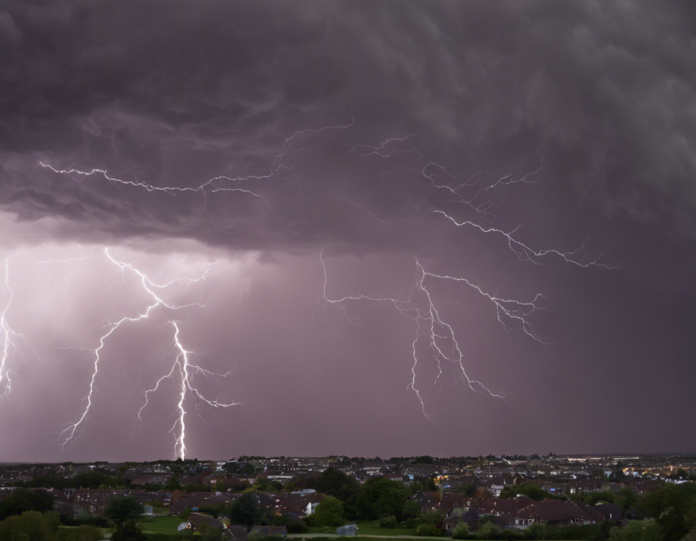Understanding Thunderstorms
Thunderstorms are common weather occurrences that can occur throughout the year in many parts of the world. They are characterized by the presence of lightning and thunder, as well as heavy rain, strong winds, and in some cases, hail. Thunderstorms usually develop in warm, moist air masses and can be brief, intense events or can last for several hours.
Formation of Thunderstorms
Thunderstorms form when warm, moist air rises rapidly into the atmosphere. As the air rises, it cools and condenses, forming clouds. If the air continues to rise and cool, it can eventually reach a point where the moisture in the air condenses into water droplets or ice crystals, leading to the development of a thunderstorm.
Stages of a Thunderstorm
-
Cumulus Stage: This is the initial stage where warm air rises, forming cumulus clouds. During this stage, the air is full of moisture and is unstable.
-
Mature Stage: In this stage, the cumulus clouds develop into towering cumulonimbus clouds, triggering heavy rain, lightning, and thunder. Strong updrafts and downdrafts are present during this phase.
-
Dissipating Stage: As the storm continues, the downdrafts become dominant, leading to the dissipation of the storm. The thunderstorm loses its intensity, and the weather begins to calm down.
Thunderstorm Weather Warnings
Thunderstorms can be accompanied by various hazards, including lightning strikes, flash floods, strong winds, and hail. To keep the public safe, weather agencies issue various warnings and advisories to alert people about imminent thunderstorms. Some common types of thunderstorm warnings include:
-
Thunderstorm Watch: This means that conditions are favorable for the development of thunderstorms in a particular area. It is a general alert to stay updated on weather developments.
-
Thunderstorm Warning: This is a more serious alert that indicates that a thunderstorm is occurring or is imminent in the warned area. People should take immediate precautions when a thunderstorm warning is issued.
-
Severe Thunderstorm Warning: This warning is issued when a thunderstorm is producing or likely to produce damaging winds of 58 miles per hour or greater and/or hail 1 inch in diameter or larger. It signifies a higher level of threat and demands immediate action.
Safety Tips During Thunderstorms
When thunderstorms are forecasted or occurring in your area, it is essential to take appropriate safety precautions to protect yourself and your property. Some important safety tips to follow during thunderstorms include:
- Seek shelter in a sturdy building or a hard-topped vehicle.
- Avoid open fields, tall trees, and bodies of water.
- Stay away from windows, doors, and electrical appliances.
- If you are indoors, do not take showers or use wired devices.
- If you are caught outside, crouch down low with only your feet touching the ground.
Frequently Asked Questions (FAQs)
- What should I do if I am driving during a thunderstorm?
-
If you are driving during a thunderstorm, it is best to pull over to a safe location away from trees and power lines. Turn on your hazard lights, avoid flooded roads, and stay inside your vehicle until the storm passes.
-
Can thunderstorms cause power outages?
-
Yes, thunderstorms can cause power outages due to lightning strikes, strong winds knocking down power lines, or damage to electrical infrastructure. It is advisable to have emergency supplies and a communication plan in place during severe weather events.
-
Is it safe to use electronic devices during a thunderstorm?
-
It is not safe to use electronic devices such as computers, phones, or wired appliances during a thunderstorm as they can be damaged by power surges caused by lightning strikes. Unplug devices and avoid using them until the storm has passed.
-
Are pets affected by thunderstorms?
-
Some pets can be fearful of thunderstorms due to the loud noises and changes in atmospheric pressure. It is advisable to create a safe space for pets indoors and provide them with comfort during storms.
-
How can I stay informed about thunderstorm warnings?
- Stay informed about thunderstorm warnings by monitoring weather reports on television, radio, or through weather apps on your smartphone. You can also sign up for emergency alerts from local authorities to receive timely notifications about severe weather in your area.
In conclusion, thunderstorms are natural phenomena that can be both awe-inspiring and dangerous. By understanding the formation of thunderstorms, recognizing different warning types, and following safety tips, you can mitigate the risks associated with thunderstorms and stay safe during severe weather events. Remember to stay informed, stay prepared, and stay safe when thunderstorms are on the horizon.








